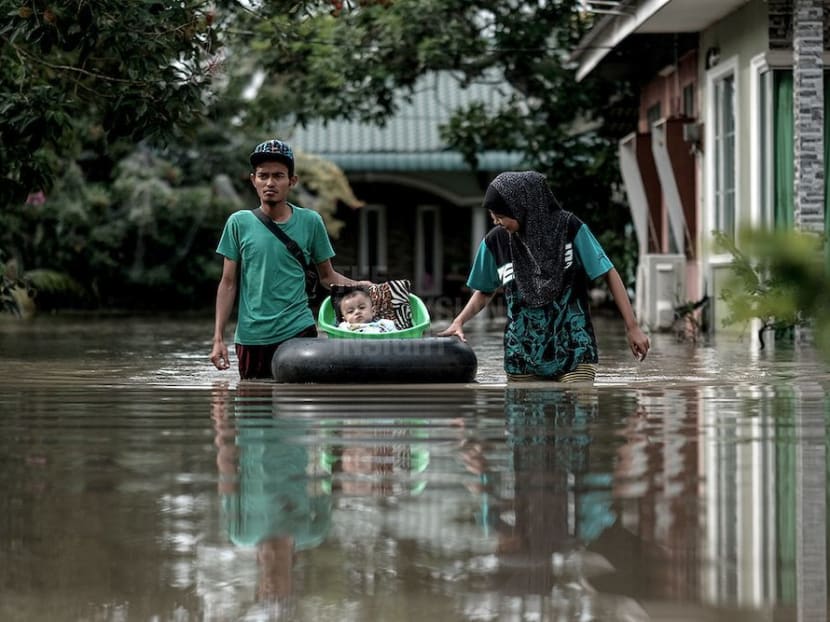Penang government denies it was ill-prepared for floods
GEORGETOWN, Penang — The Penang government insists it was not ill-prepared to deal with floods, but the massive deluge that wrecked havoc in the state over the weekend was unprecedented and could not be avoided.

A couple in Permatang Pauh wade through the flood with their baby using an improvised float on Nov 6, 2017. Photo: The Malaysian Insight
GEORGETOWN, Penang — The Penang government insists it was not ill-prepared to deal with floods, but the massive deluge that wrecked havoc in the state over the weekend was unprecedented and could not be avoided.
State Environment, Welfare and Caring Society committee chairman Phee Boon Poh told The Malaysian Insight that response teams were well-trained, but admitted that the large-scale impact of the 15-hour downpour that started on Saturday (Nov 4) afternoon “caught them by surprise”.
And even as relief efforts continue for the thousands affected by the disaster, criticisms have been flooding in against the state government’s apparent lack of foresight and preparation, which some say led to a delayed response to the flood.
“Penang is prepared, but every battle is different and the terrain changes,” he said.
“However, in a few hours, we were able to bounce back.”
Seven people were killed and more than 7,000 people have so far been evacuated to shelters around the state after strong winds and heavy rain caused landslides and flooding in much of the state over the weekend.
The mainland was the hardest-hit part of the state. Seberang Prai Utara has 22 centres with 4,549 people, while Seberang Prai Tengah has 29 centres with 2,430 people. Seberang Prai Selatan has three centres with 371 people.
On the island, the North-east district has three centres with 36 people, while the southwest district has two centres with 112 people.
Mr Phee also refuted claims that the floods were caused by overdevelopment and projects on hill land and slopes – issues that Penang civil society and environmental groups had been raising in the light of last month’s landslide in Tanjung Bungah, which killed 11 people.
“There are more victims on the mainland than the island, which has more development,” said Mr Phee.
“There are also no hill slope projects in Seberang Prai Utara,” he said.
Chief Minister Lim Guan Eng said on Sunday that 80% of the state was hit by the flash floods, which was unavoidable as the volume of rainfall – the highest in state history at 315mm – was too severe for the existing natural and manmade drainage systems to handle.
Penang had experienced 119 flash floods between 2013 and last month. This works out to a minimum of 20 incidents each year – 22 flash floods in 2013, 2014 (20), 2015 (26), 2016 (30) and as at October 15 (21).
DEPLOYING THE ARMY
Mr Lim had also appealed to Deputy Prime Minister Ahmad Zahid Hamidi to deploy soldiers for flood relief efforts.
Mr Phee said the state government had to ask for the help because it did not have the specialised equipment and vehicles that the military had at its disposal.
There was also insufficient manpower to work on the ground, he said.
“If Penang still had its Voluntary Patrol Unit (PPS), I would have more than 9,000 people that I could mobilise to help in the flood relief.”
The PPS was a voluntary unit formed in 2011 by the Penang executive council aimed at getting members of the public to fight crime. Its members wore purple vests.
On Merdeka Day in 2014, police arrested over 150 PPS members. Later, PPS was declared illegal and deemed a threat to public security by the Home Ministry after the Registrar of Societies labelled it an “unregistered” body.
“I could have sent them out to give people a sense of security, convince them to leave their homes for evacuation centres. The men in purple could help make the people feel safe.”
CLEANUP PLANS READY

Mr Phee said three days after the floods hit, there was still much to be done to help the victims as waters begin to recede.
He said while search teams continued to comb the state for residents who might still be trapped in their homes, plans had been drawn up to organise cleanup crews in all five districts.
Councillors, village development and security committee members and others would be put in charge to coordinate the work with volunteers, he said.
Mr Phee said cleaning equipment such as mops, pails, and detergent, were needed in large quantities, as were water hoses, water jets and brushes. People with heavy vehicles were also welcome to offer their vehicles to transport debris.
“Sanitation is next. Houses damaged by floodwaters will need to be cleaned,” he said.
“We are now training people, volunteers, for this... they will be put in teams of five, and assigned to sweep, mop and wash.
“The clean-up teams will go from house to house to help the victims clean up.” THE MALAYSIAN INSIGHT






